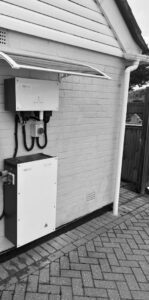This article was kindly contributed by Dave Roberts, UK MD at energy storage specialist GivEnergy.
Installations of home battery storage systems are on the rise. Whether coupled with solar PV panels or as a standalone system, battery storage allows homeowners to cut energy bills and carbon emissions.
Before investing in a home battery, you need to decide where in your property to install your system.
A loft installation can be tempting, especially for properties with limited space. However, there are a few recent changes to guidelines you need to be aware of.
Here’s what you need to know.
Should you install a home battery storage system in your loft? Here’s what the guidelines say:
In March 2024, the British Standards Institute (BSI) published new guidelines in a document entitled PAS 63100:2024. And it has something to say about battery installations in lofts.
Section 6.5.5 states that batteries shall not be installed in ‘voids, roof spaces, or lofts.’
Reasons for this likely revolve around fire safety. Some loft spaces may lack ventilation. Meanwhile, older loft spaces may contain flammable insulation materials.
So, should you install a home battery in your loft?
According to current guidelines: no.
Are guidelines likely to change?
The latest guidelines may be disappointing for some.
Disappointing for homeowners who want to reap the benefits of a home battery storage system, but for whom space is limited. A loft installation may be among the only viable options. Recent fire incidents linked to home batteries – most notably in Germany, Austria, and Australia – have brought safety issues to the fore.
However, it’s worth noting the above cases all involved nickel manganese cobalt (NMC) batteries – a type of lithium-ion battery prone to thermal runaway.
Increasingly, home battery storage systems are using lithium iron phosphate (LiFePO4) battery chemistry.
LiFePO4 is a type of lithium-ion battery less prone to thermal runaway and therefore, less of a fire risk. With this in mind, it’s possible the guidelines around loft installations could change.
Changes to guidelines could be a positive step in making home battery storage systems more accessible for homeowners with limited space.
Where else can you install your home battery storage system?
-
The main living area of your home
-
Garage
-
Outdoors (assuming your system is IP65 rated)

An outdoor home battery storage system by GivEnergy
Installation safety tips
Regardless of where you install your home battery, pay attention to the following:
-
Ventilation
Ensure the area around your system is well ventilated.
-
For outdoor installations…
… cover your system with a canopy to avoid the heat sink clogging up with leaves and other debris.
-
Sunlight
Keep your system away from direct sunlight to avoid risk of overheating.
The (safe) path to energy freedom in your home
Installing a home battery storage system is the first step towards making your home more energy independent.
Home batteries are overwhelmingly safe, especially with the shift towards LiFePO4 battery chemistry.
However, enhanced safety shouldn’t detract from the need to follow relevant regulations and guidelines when it comes to installation. That includes PAS 63100:2024.
The guidelines around loft installations may be disappointing to those with limited space. Nonetheless, you can take comfort from the fact that there are a whole load of other installation options. Moreover, safer battery chemistry means the guidelines could be subject to change.
In the meantime, it’s up to all of us in the industry to do our best…
… do our best to make sure home batteries are safe, but also as widely accessible as possible.


